3.3 The National Policy
John A. Macdonald’s National Policy remains a touchstone of Canadian economic history. It combined three core elements – infrastructure, tariffs, and population growth — as a strategy to reshape and expand the post-Confederation economy. It was not, however, a single policy; it was a combination of several strategies which had complementary qualities that, once recognized, were shrewdly re-presented to Canadians as a comprehensive package.
Many of the elements of the National Policy were in place very early in the conversation about Confederation or at least they were implied. Barriers to trade between the BNA colonies were eliminated as they became provinces. Funding for the railway construction that linked all four original provinces was promised at the outset. Expansion into the West to provide a vent for surplus Canadian farm population (magically transforming them into prairie settlers) was a first-level objective. What was added onto this framework by Macdonald’s several administrations was something rather more ambitious.
The Railway
The trans-continental railway is the most obvious and arguably the most lasting element of what became known as the National Policy. It both served to deliver manufactured goods to captive markets in the West and acted as a critical element in populating the Prairies with colonists. Moreover, by the end of the century, the railway had demonstrated an ability to crush local industries in the far west by flooding the market with mass-produced central Canadian products.
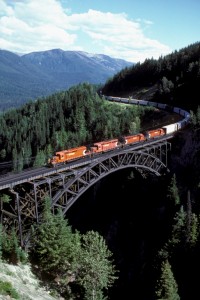
The railway fulfilled several functions at once. It is, obviously, a means of moving goods and people: it is transportation infrastructure. For Canada in the 1880s and 1890s, it also served as an instrument of control, the means by which troops and the NWMP could be sped to trouble spots. This was clearly demonstrated in the Canadian militia’s quelling of the 1885 uprising in Saskatchewan. The CPR — both its rail and telegraph service — provided a quick and critical communications system that enabled Canadian state power to extend far beyond southern Ontario or the St. Lawrence Valley. One of the challenges faced by crown colony governors on the West Coast had been the interminable slowness of communications between Victoria or New Westminster and London. After 1886, Canada’s imperial representatives in the West or on the Pacific Coast, by contrast, could receive instructions and reinforcements in a matter of days, if not hours.
The CPR, however, was also a major land owner and very much in the settlement business. It was clearly in the best interests of the Railway to get farmers onto the land so that they could buy freight and ship grain. Railways were, as well, a critically important component in Canada’s economic transformation. Historians Paul Craven and Tom Traves made this observation over 30 years ago:
Railways were not just simple transportation companies. […] In some respects they operated almost like states unto themselves; their company rules had the force of law, they employed their own police, and their executives, as the Grand Trunk’s goods manager put it, were ‘as important as generals in an army or Ministers of State.’[1]
The need for rails, rolling stock, engine parts, and the metal for seats and carriage doors meant everything had to be fabricated according to the individual railway’s specification. Universal standards had not come into play yet, even within single companies. (The Great War would play an important role in moving that process forward.) Everything — including machine parts and simple fasteners like nuts and bolts — needed to be made (and repaired) in-house. As early as 1871, the Great Western Railway (GRW) employed 984 people at its Hamilton shops, paying out the then-astronomical sum of $500,000 annually in wages. The GWR was the largest but the Grand Trunk (in Pointe Saint-Charles near Montreal) employed 790 and the four next largest companies (two of them in Toronto, one in Brantford, and the fourth in Montreal) employed more than a 1,000 between them.[2] And this all predates the creation of the Canadian Pacific Railway, not to mention the many streetcar systems that appeared in towns and cities across the country from the 1890s to the 1920s.
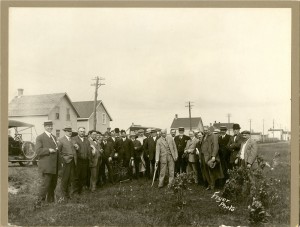
The railway technology shrank Canada; it made long-distance travel manageable and should be appreciated as a revolutionary achievement. In the 1850s, the Prairie West was still perceived by the Canadians and Maritimers as an extension of the Great American Desert; an arid plain with little agricultural potential and fearsome locals with whom to contend. A generation later, that perspective was replaced with a more optimistic view that changed Canadian attitudes toward the interior of North America. This was reflected most clearly in the railway’s impact on land use.
Immigration and Land
The second piece of the National Policy was immigration and settlement of the West. By creating a productive agricultural frontier of independent producers, the reasoning went, Canada would also be generating an internal marketplace for clothing, farm machinery, and household goods produced in the original four provinces. And, of course, the railway would be the means of delivering that population and those goods to the West.
Broadly speaking, the CPR was an instrument of change. It delivered settlers to the West, whose goal it was to extend the reach of European-style agriculture. The whole concept of a settler — someone who establishes a permanent and fixed residence where, it is assumed (almost always incorrectly), no one lived before — is bound up in farming and ranching. To see the significance of this, observe how the coal miners of Drumheller or the Crowsnest Pass are seldom described as settlers, despite their long tenure on (and below) the landscape. The CPR thus did not just deliver settlers, it made them.
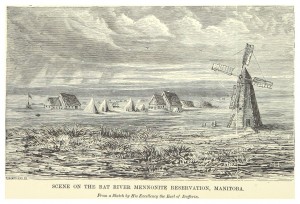
The CPR, as a land agency, was directly involved in recruitment and land sales, but so too was Ottawa’s land policy. At the heart of this system was the township survey, made up of 36 sections of 640 acres of land. Of the 36 sections, two were reserved for schools, one (sometimes more) for the HBC as part of the sale price of Rupert’s Land, and about half of the remaining sections for the Canadian Pacific Railway. What was left was available as free homestead land and it was all geometrically rigid. Sections of 160 acres (64.7 hectares) were mapped out with a blind disregard for topographical barriers, bodies of water, or variations in environmental conditions like wind, rainfall, or soil quality. This unit of measure was almost sacred: the 1 square-mile section and the quarter-section were the currency of homesteading in the United States where, similarly, the whole of the West had been overlain with a graph-paper pattern. Bernard DeVoto, a historian of the American West, argued in 1953 that the quarter section acquired a huge symbolic value as “the buttress of our liberties, and the cornerstone of our economy.” What he had to say on this score is as apposite for Canada as for the US:
It was certainly true … that if you owned 160 acres of flat Iowa farmland or rolling Wisconsin prairie, you had, on the average, a farm which would support your family and would require all its exertions to work. So the quarter-section, thought of as the proper homestead unit, became the mystical one. But in the arid regions 160 acres were not a homestead. They were just a mathematical expression whose meanings in relation to agricultural settlement were disastrous.[3]
As in the United States, Canadian homesteaders were promised a whole section of free land under the Dominion Lands Act (1871). All the pioneer settler had to do was put a quarter-section (40 acres or 16.9 hectares) under the plough and build a house on it within three years. Successful homesteaders were, furthermore, entitled to obtain the title to a neighbouring section once they had “proved up” their first quarter-section. This practice led to a rapid expansion of staked and claimed farmland across the Plains.
It was with regard to settling the West that the National Policy struggled most. It was wrongly assumed at the outset that Ontarians and Canadians from further east would flood the Prairies. Instead, they continued heading south. Immigrant recruitment was slow to make gains and many newcomers turned into Canadian emigrants, joining the exodus of Dominion citizens leaving for the United States. Through to 1901, Canada continued to be a net loser of population. The Canadian West was growing in population numbers, but nothing like as fast as the American West. Ironically, it was under the Liberal administration of Wilfrid Laurier (Prime Minister from 1896-1911) that things suddenly accelerated. Thereafter, from 1896 to the Great War, the rate of Canadian population growth outstripped that of the United States, and the Dominion experienced net population growth for the first time since Confederation.
The Tariff
Only a fraction of the landscape encountered by pre-War settlers had ever encountered the plough before their arrival. The fact that the CPR — an infrastructure built on steel rails and wheels and carriages with the ability to move very heavy freight easily — coincides with the spread of the chilled steel plough in North America, is not a coincidence. Wooden ploughs (sometimes called mouldboards) were far less effective in breaking the soil for the first time, particularly the densely packed stuff of which the Prairies is made. The agricultural machinery industry in Ontario was already well advanced by this stage. The links between steel production, agricultural equipment, and railway development are central to the CPR story. The CPR had a stake in the growth of manufacturing capacity in the East and in the shipment of manufactured goods — and, thus, in the success of the tariff.
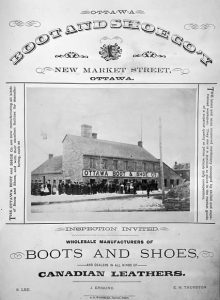
The tariff placed cheap imports from the United States at a disadvantage to protect embryonic Canadian industries. This approach was tried and tested in many countries. (The mid-century American termination of reciprocity with British North America was itself based in part on a fear that British goods would be introduced via BNA and then sold cheaply (or “dumped”) in the United States, thereby killing New England’s manufacturing sector.) Until the mid-1870s, there was sufficient demand in the North American economy that Canadian tariffs could be kept at a moderate level. By the late 1870s, however, competition from American producers was on the upswing. Canadian manufacturers were calling for protection for their products, and there were more of these manufacturers than ever before. The tariff policy was unpopular in the Maritimes and with those Canadians — many of them Liberals — who looked forward to a return to reciprocity. Beginning in 1878, the Macdonald administration assembled a suite of tariffs that ranged from 17.5% to 20%. These were predominantly assessed on the products of heavy industry and mining.[4]
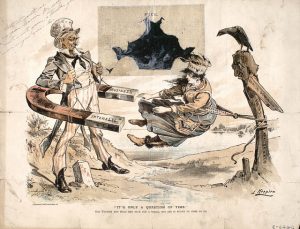
The tariff may have been necessary, but it was unpopular, even with Conservatives. Every Canadian government from the 1860s-1911 held out the prospect of a return to reciprocity with the United States. Having a good trading relationship with the large economy next door only made sense, but it proved to be unappealing to American and Canadian manufacturers alike. The Liberal Party — with much of its base in rural Canada — was more aggressive in calling for free trade with the United States. Ironically, it was under Laurier that tariffs surged upward to over 30% on certain manufactured goods. After 15 years in office, Laurier went back to the electorate with a free trade agreement in hand, already approved by the US government. The voters turfed him out in 1911 and handed the reins to a staunchly protectionist Conservative leader, Robert Borden, whose campaign slogan was the memorable, “No truck nor trade with the Yankees.”[5]
By the end of the pre-War era, however, the National Policy had done its work. There were competing railways, Canada had a healthy manufacturing sector, the economy had diversified in ways that would sustain further industrial growth, prairie settlement was well advanced, and the wheat boom was (with a few interruptions) underway. The National Policy had done one other thing that had a sustained consequence for Canada: it created a wall over which products might not pass, but through which capital investment moved as though a barrier were not there. American investment in Canadian productive capacity accelerated with the National Policy. Peter DeLottinville’s study of a town straddling the Maine-New Brunswick border shows how capital from Canada’s financial centre, Montreal, was joined by American money that hoped to make a profit from selling protected Canadian cotton products inside the protected Canadian market. [6] British money similarly arrived in Canada, although it tended to come in portfolio investments rather than directly from industry. The irony of the tariff, then, is that it protected industry against competition while opening up the Canadian economy to international influences through investment.
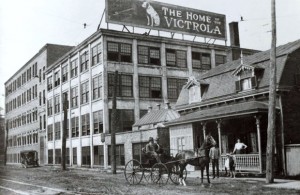
Tariff walls could not, therefore, isolate the Canadian economy. The Canadian-American border was utterly porous with regard to people and money, regardless of how much of a barrier it was to manufactured goods. The Canadian-American border was also wide open with regard to ideas. The southern alignment of the Canadian Pacific Railway and the building of connecting lines to the south ensured that Calgary would be influenced by centres in Montana and Idaho, Winnipeg by Milwaukee, Minneapolis, and Chicago, and in BC, the Kootenays by Spokane, and Vancouver by Seattle and San Francisco. These influences can still be seen in commercial and residential architectural styles from the Victorian and Edwardian eras but, at the time, they were most clearly evident in working-class affairs.
Cause and Effect
No area of historical research attracts debate quite like economic history. In the case of late 19th century Canada, economic historians are divided on several issues. Providing land for free was universally regarded as necessary to the settlement of the West, but was it? In giving away land, was Ottawa forgoing significant revenues? (Certainly the CPR and other land agents did very well by land sales.) Was the subsidy to the CPR necessary? Was it excessive? Were tariffs — especially those of as much as 30% — essential? At what point did they cease being about protection of embryonic industries and a guarantee of profits for inefficient industries? Or, were they principally a tax on commerce, a means of raising government revenues?
These questions are raised because of the opportunity costs entailed — where might Canada have spent railway subsidies otherwise? The objection raised by Western farmers at the time was that they were paying for Canadian industrialization and were held back from being more productive because they could not purchase goods in a freer market.
In short, historians have not resolved whether the National Policy did the job or not, whether its success rests on one strategic pillar or on all three. What is certain is that the National Policy succeeded as an organizing principle and a way of encapsulating Canada’s economic unification and transformation. Macdonald and his peers wanted to see a modernizing Canada. What they got was one which had to make room for new social categories and challenges.
Key Points
- Three policy areas — railway construction, immigration, and protective tariffs on manufactured goods — came to be considered as a package known as the National Policy.
- The Canadian Pacific Railway connected the southern half of the Dominion. It was also an important land dealer, manufacturer, and employer.
- Immigration into the West began very slowly, showing few returns to the National Policy before the late 1890s.
- The resettlement of the West involved imposing a new, systematic, artificial, and highly standardized system of land ownership.
- Tariffs aimed to protect central Canadian industries that were exposed to more cheaply priced American and British manufacturers’ products.
- Western farmers complained that they paid too much for tariff-protected Canadian goods.
- The tariff wall encouraged new patterns of investment in Canadian industry.
Attributions
Figure 3.9
The Stoney Creek Bridge by David R. Spencer is used under a CC BY SA 3.0 license.
Figure 3.10
Turning of the Sod at Canadian Car & Foundry by City of Thunder Bay Archives is in the public domain. This image is available from Thunder Bay Archives under the reference number 1991-6 #129.
Figure 3.11
Dent(1881) 1.378 Manitoba by John Charles Dent is in the public domain. This image is available from British Library under the accession number HMNTS 9555.f.7..
Figure 3.12
Ottawa Boot & Shoe Factory, New Market Street (Online MIKAN no.3246578) by William James Topley / Library and Archives Canada / C-002207 is in the public domain.
Figure 3.13
“It’s Only a Matter of Time.” Old Fogyism may hold her back for a while, but she is bound to come to us (Online MIKAN no.2837922) by Puck Magazine / Library and Archives Canada, Acc. No. 1959-71-37 is in the public domain.
Figure 3.14
RCA Victor factory by Jeangagnon is in the public domain.
- Paul Craven and Tom Traves, “Canadian Railways as Manufacturers, 1850-1880,” Historical Papers/Communications Historiques (1983): 254, reprinted in Perspectives on Canadian Economic History, ed. Douglas McCalla (Toronto: Copp Clark Pitman, 1987): 118. ↵
- Kenneth Norrie and Douglas Owram, A History of the Canadian Economy (Toronto: Harcourt Brace Jovanovich Canada, 1991), 237-9. ↵
- Bernard DeVoto, “Introduction” to Wallace Stegner, Beyond the Hundredth Meridian (Toronto: Penguin Books, 1954 and 1992): xix. ↵
- Kenneth Norrie and Douglas Owram, A History of the Canadian Economy (Toronto: Harcourt Brace Jovanovich Canada, 1991), 312-4. ↵
- Ibid., 314-5. ↵
- Peter DeLottinville, “Trouble in the Hives of Industry: The Cotton Industry comes to Milltown, New Brunswick, 1879-1892,” in Labour and Working-Class History in Canada: A Reader, eds. David Frank and Gregory S. Kealey (St. John’s: Institute of Social and Economic Research, Memorial University of Newfoundland, 1995): 134-6. ↵

